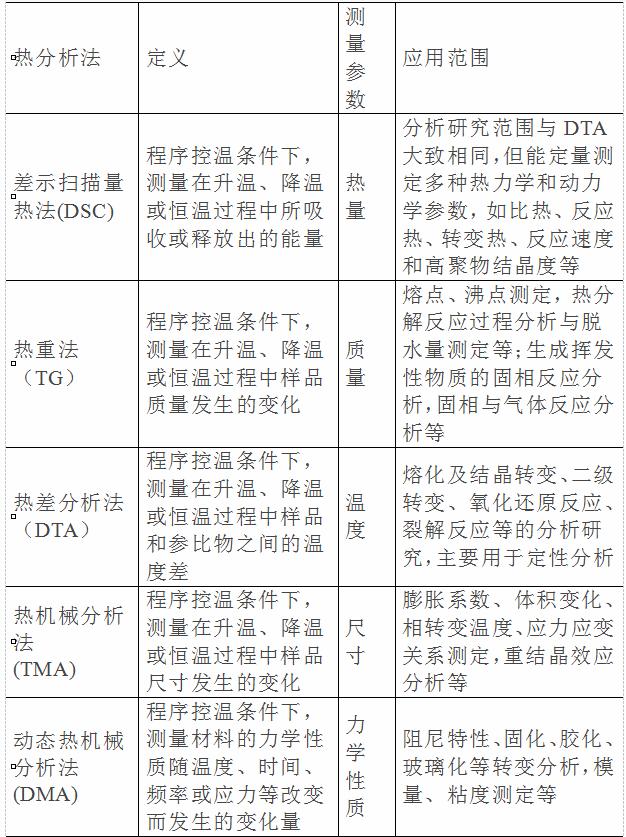What is thermal analysis? What are the common thermal analysis methods?
Date:2023-03-13 15:41:36 Views:3653
Thermal analysis is a technical method to measure and analyze the relationship between material thermodynamic parameters or physical parameters and temperature. The so-called thermal analysis refers to the analysis of the change of the corresponding physical and chemical properties of the sample by controlling the change of its temperature. According to the induction and classification of the International Association for Thermal Analysis (ICTA), the current thermal analysis methods are divided into nine categories and seventeen kinds, while at present we commonly use five kinds, namely: differential scanning calorimetry (DSC), thermogravimetry (TG), thermal differential analysis (DTA), thermomechanical analysis (TMA), dynamic thermomechanical analysis (DMA) and other five methods. The following article will briefly introduce thermal analysis. Let's have a look!
_20230313153955_162.jpg)
The most common means of thermal analysis are thermogravimetric analysis (TG), differential thermal analysis (DTA) and differential scanning calorimetry (DSC).
The three thermal analysis methods have their own advantages and can be used separately or jointly. How to choose? Let's start from the definition and understand these representation methods.
TG: Under programmed temperature control, measure the change of sample mass (m) with temperature. If you need to know the change of sample quality (such as adsorption, desorption, decomposition, etc.) during the heating or cooling process of the sample, please select TG. For example, carbon deposition often occurs in industrial catalysts, and the amount of carbon deposition can be determined by TG characterization.
DTA: Measure the change of temperature difference (△ T) between reference and sample with temperature (T) under program control temperature. The difference between DTA and TG is that the measured value changes from mass to temperature difference. The selected test temperature difference is because many physical and chemical changes (such as melting, phase change, crystallization, etc.) that occur during the heating process do not produce quality changes, but represent the release or absorption of heat, resulting in the temperature difference between the sample and the reference material. DTA can find the melting point, crystal transition temperature, glass transition temperature and other information of the sample.
DSC: Measure the difference (△ Q) between the energy given to the reference and the sample as a function of temperature (T) at the programmed temperature. During the whole test process, the temperature difference between the sample and the reference material is controlled within a very small range. When the sample undergoes physical or chemical changes, the temperature control device will input a certain amount of power energy to maintain temperature balance. DSC can be simply regarded as an upgraded version of DTA. DSC is indeed developed from DTA. Because of the material of the sample cell, the traditional DTA instrument can only measure the temperature difference and cannot prepare to measure the change of heat and enthalpy. By changing the material and structure in the later stage, it is possible to change from temperature difference to energy difference (heat flow type). Finally, there is a DSC (power compensation type) that directly measures the input heat difference. DSC has the advantages of high sensitivity and can quantitatively measure physical quantities such as enthalpy and specific heat capacity.
Several common thermal analysis methods and their physical and chemical parameters

Significance of thermal analysis
Thermal analysis of materials can quickly and accurately determine the changes of crystal transformation, melting, sublimation, adsorption, dehydration, decomposition and other changes of materials. It has a wide range of applications in characterizing the thermal, physical, mechanical and stability of materials. Thermal analysis of materials can identify the types of materials, judge the advantages and disadvantages of materials, and help product research and development, quality control and process optimization in the field of materials and chemistry.
The above is the relevant content of thermal analysis organized by the core detection team. I hope it can help you. Our company has a team of professional engineers and industry elites, and has three standardized laboratories with an area of more than 1800 square meters, which can undertake various test projects such as electronic component testing and verification, IC authenticity identification, product design and material selection, failure analysis, functional testing, factory incoming material inspection and tape weaving.




 Weixin Service
Weixin Service

 DouYin
DouYin
 KuaiShou
KuaiShou





















